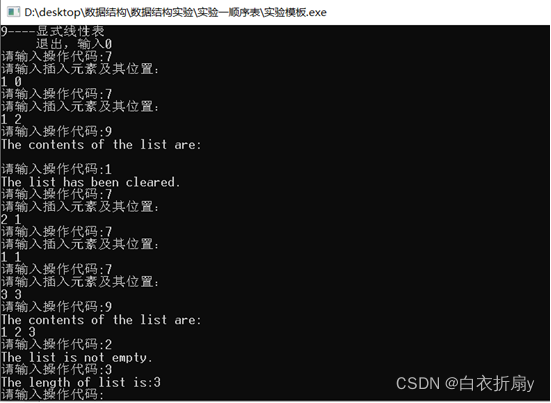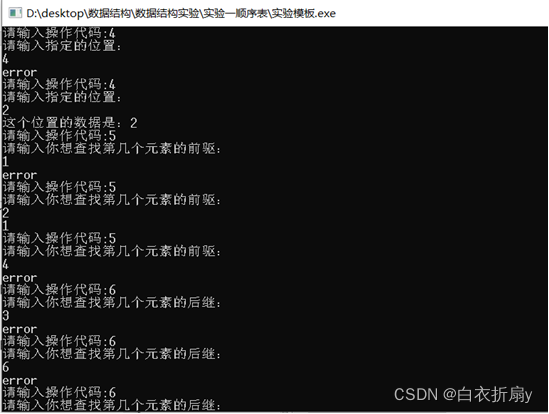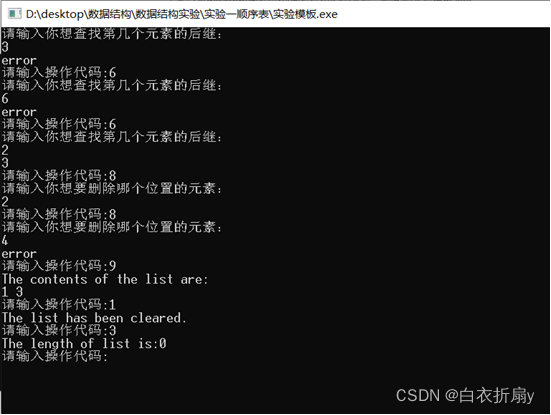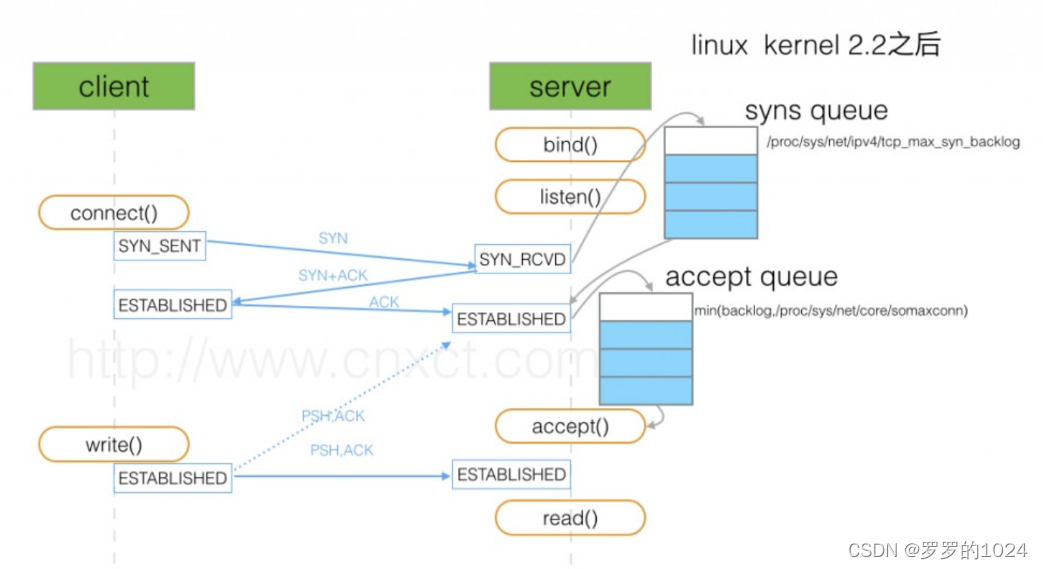当前位置:网站首页>Have you really learned the operation of sequence table?
Have you really learned the operation of sequence table?
2022-04-23 15:03:00 【White folding fan y】
Newcomer Xiaobai's blog
️ I hope you will pay more attention
It will be updated frequently in the future ~
️ Personal home page : Collection and attention , Never get lost ~ ️
Operation of sequence table
Preface
Programming to achieve the following basic operations of the sequence table : Create sequence table , Modify sequence table , Insert sequence table , Delete order table .

Tips: It's a little long , Little Lord, please watch patiently ~~
One 、 Purpose
Deep understanding of the logical structure of the sequence table 、 Physical structure and other concepts , Master the programming implementation of the basic operation of the sequence table , Note that the sequence table is inserted 、 The movement of data elements during operations such as deletion . When writing a program , Consider the robustness of the program , Master the method of returning function results through function parameters .ヾ(◍°∇°◍)ノ゙
Two 、 step
1. Define storage representation
For example, the maximum length of the sequence table , Storage base address , Watch length, etc .
// Define storage representation
typedef int ElemType; // Definition ElemType The type is int
# define MAXSIZE 100 // The maximum length of the sequence table
typedef struct // If you don't use it later , The structure name can be omitted
{
ElemType *elem; // Storage base address
int length; // Current table length ( Especially the number of elements )
} SqList;
2. Define the operation function
Initialize the function , Construct functions that destroy linear tables DestoryList, Clear the function of linear table ClearList, Find the function of linear table length GetLength, A function that determines whether the linear table is empty ListEmpty, Gets the content of the element at the specified position in the linear table GetElem, Seeking precursor 、 Subsequent functions , A function that inserts an element at a specified position in a linear table ListInsert, Delete linear table specified location element ListDelete, Show linear table functions and exit operations .
// Define the operation function
typedef int Status;
Status InitList(SqList &L)
{
// Construct an empty linear table L.
L.elem = new ElemType[MAXSIZE];
L.length = 0; // The length of the empty meter is 0
return 1;
}
void DestroyList(SqList &L)
{
if (L.elem) delete[ ] L.elem; // Free up storage space
L.length=0;
L.elem=NULL;
}
int GetLength(SqList L)
{
return L.length;
}
bool ListEmpty(SqList L)
{
if (L.length==0)
return true;
else
return false;
}
Status ListInsert(SqList &L,int i,ElemType e)
{
if(i<1 || i>L.length+1) return -1; //i Illegal value
if(L.length==MAXSIZE) return -1;
// The current storage space is full
for( int j=L.length-1; j>=i-1 ; j--)
L.elem[ j+1]=L.elem[ j]; // The insertion position and subsequent elements are moved backward
L.elem[i-1]=e; // The new element e Put in the i A place
++L.length; // Table length increase 1
return 1;
}
Status ListDelete(SqList &L,int i, ElemType &e)
{
if((i<1)||(i>L.length)) return -1; //i Illegal value
e=L.elem[i-1];
for (int j=i; j<=L.length-1; j++)
L.elem[ j-1]=L.elem[j];// The element after the deleted element moves forward
--L.length; // Watch length minus 1
return 1;
}
Status ListPrior(SqList &L,int i,ElemType &e)
{
if((i<2)||(i>L.length)) return -1; //i Illegal value
else cout<<L.elem[i-2]<<endl;
return 1;
}
Status ListNext(SqList &L,int i,ElemType &e)
{
if((i<1)||(i>L.length-1)) return -1; //i Illegal value
else cout<<L.elem[i]<<endl;
return 1;
}
void DisplayList(SqList L)
{
for(int i=1; i<=L.length; ++i)
cout<<L.elem[i-1]<<" ";
cout<<endl;
}
void ClearList(SqList &L)
{
L.length=0; // Set the length of the linear table to 0
}
Status GetElem(SqList L,int i,ElemType &e)
{
// Judge i Whether the value is reasonable , If it's not reasonable , return ERROR
if (i<1||i>L.length) return -1;
e=L.elem[i-1]; // The first i-1 The first unit stores the i Data
return 1;
}
3. The menu style is adopted to make the operation more convenient and clear .
This function is used to realize a small menu
void show_help()
{
cout<<"******* Data Structure ******"<<endl;
cout<<"1---- Empty the linear table "<<endl;
cout<<"2---- Determine whether the linear table is empty "<<endl;
cout<<"3---- Find the length of the linear meter "<<endl;
cout<<"4---- Get the location element specified in the linear table "<<endl;
cout<<"5---- Seeking precursor "<<endl;
cout<<"6---- Succ "<<endl;
cout<<"7---- Insert the element in the specified position of the linear table "<<endl;
cout<<"8---- Delete linear table specified location element "<<endl;
cout<<"9---- Show linear table "<<endl;
cout<<" sign out , Input 0"<<endl;
}
4. Debug the experimental code and test it , The experimental results are obtained .
Here comes the complete code :
#include <iostream>
using namespace std;
// Define storage representation
typedef int ElemType; // Definition ElemType The type is int
# define MAXSIZE 100 // The maximum length of the sequence table
typedef struct // If you don't use it later , The structure name can be omitted
{
ElemType *elem; // Storage base address
int length; // Current table length ( Especially the number of elements )
} SqList;
// Define the operation function
typedef int Status;
Status InitList(SqList &L)
{
// Construct an empty linear table L.
L.elem = new ElemType[MAXSIZE];
L.length = 0; // The length of the empty meter is 0
return 1;
}
void DestroyList(SqList &L)
{
if (L.elem) delete[ ] L.elem; // Free up storage space
L.length=0;
L.elem=NULL;
}
int GetLength(SqList L)
{
return L.length;
}
bool ListEmpty(SqList L)
{
if (L.length==0)
return true;
else
return false;
}
Status ListInsert(SqList &L,int i,ElemType e)
{
if(i<1 || i>L.length+1) return -1; //i Illegal value
if(L.length==MAXSIZE) return -1;
// The current storage space is full
for( int j=L.length-1; j>=i-1 ; j--)
L.elem[ j+1]=L.elem[ j]; // The insertion position and subsequent elements are moved backward
L.elem[i-1]=e; // The new element e Put in the i A place
++L.length; // Table length increase 1
return 1;
}
Status ListDelete(SqList &L,int i, ElemType &e)
{
if((i<1)||(i>L.length)) return -1; //i Illegal value
e=L.elem[i-1];
for (int j=i; j<=L.length-1; j++)
L.elem[ j-1]=L.elem[j];// The element after the deleted element moves forward
--L.length; // Watch length minus 1
return 1;
}
Status ListPrior(SqList &L,int i,ElemType &e)
{
if((i<2)||(i>L.length)) return -1; //i Illegal value
else cout<<L.elem[i-2]<<endl;
return 1;
}
Status ListNext(SqList &L,int i,ElemType &e)
{
if((i<1)||(i>L.length-1)) return -1; //i Illegal value
else cout<<L.elem[i]<<endl;
return 1;
}
void show_help()
{
cout<<"******* Data Structure ******"<<endl;
cout<<"1---- Empty the linear table "<<endl;
cout<<"2---- Determine whether the linear table is empty "<<endl;
cout<<"3---- Find the length of the linear meter "<<endl;
cout<<"4---- Get the location element specified in the linear table "<<endl;
cout<<"5---- Seeking precursor "<<endl;
cout<<"6---- Succ "<<endl;
cout<<"7---- Insert the element in the specified position of the linear table "<<endl;
cout<<"8---- Delete linear table specified location element "<<endl;
cout<<"9---- Show linear table "<<endl;
cout<<" sign out , Input 0"<<endl;
}
void DisplayList(SqList L)
{
for(int i=1; i<=L.length; ++i)
cout<<L.elem[i-1]<<" ";
cout<<endl;
}
void ClearList(SqList &L)
{
L.length=0; // Set the length of the linear table to 0
}
Status GetElem(SqList L,int i,ElemType &e)
{
// Judge i Whether the value is reasonable , If it's not reasonable , return ERROR
if (i<1||i>L.length) return -1;
e=L.elem[i-1]; // The first i-1 The first unit stores the i Data
return 1;
}
int main()
{
char operate_code;
show_help();
// Define linear table variables , Such as SqList L;
SqList L;
// Call the initialization linear table function , Such as Init_List(L);
InitList(L);
ElemType e;
int i;
while(1)
{
cout<<" Please enter the operation code :";
cin>>operate_code;
if(operate_code=='1')
{
cout<<"The list has been cleared."<<endl;
ClearList(L);// Call the operation function
}
else if (operate_code=='2')
{
if(ListEmpty(L))
cout<<"The list is empty."<<endl;
else
cout<<"The list is not empty."<<endl;
}
else if (operate_code=='3')
{
cout<<"The length of list is:"<<GetLength(L)<<endl;
}
else if (operate_code=='4')
{
cout<<" Please enter the specified location :"<<endl;
cin>>i;
if(GetElem(L,i,e) == 1) cout<<" The location of the data is :"<<e<<endl;
else cout <<"error"<<endl;
}
else if (operate_code=='5')
{
cout<<" Please enter the precursor of which element you want to find :"<<endl;
cin>>i;
if(ListPrior(L,i,e) == -1) cout<<"error"<<endl;
}
else if (operate_code=='6')
{
cout<<" Please enter the successor of the element you want to find :"<<endl;
cin>>i;
if(ListNext(L,i,e)==-1) cout<<"error"<<endl;
}
else if (operate_code=='7')
{
cout<<" Please enter the inserted element and its location :"<<endl;
cin>>e>>i;
ListInsert(L,i,e);
}
else if (operate_code=='8')
{
cout<<" Please enter where you want to delete the element :"<<endl;
cin>>i;
if(ListDelete(L,i,e)==-1) cout<<"error"<<endl;
}
else if (operate_code=='9')
{
cout<<"The contents of the list are:"<<endl;
DisplayList(L);
}
else if (operate_code=='0')
{
break;
}
else
{
cout<<"\n Opcode error !!!"<<endl;
show_help();
}
}
// Call the destroy linear table function , Such as Destroy_List(L);
DestroyList(L);
return 0;
}
Tips: It's almost over ~~
3、 ... and 、 Experimental data recording and operation results
Call each operation through the menu :
1️⃣ insert data ( data , Location ), When the input position is illegal , The linear table does not show . Such as :(1,0)、(1 ,2). Then insert it correctly 3 Data (2,1)、(1,1)、(3,3);
2️⃣ Display the data in the sequence table , Screen output 1, 2, 3;
3️⃣ Sentenced to empty , The screen output sequence table is not empty ;
4️⃣ Output sequence table length , Screen output 3;
5️⃣ Get the specified location element , The specified position to be measured is 【1,3】 Situations outside the scope and within the scope ;
6️⃣ location , Input :4, Output : non-existent , Input 2, The output position is 2;
7️⃣ Ask for a direct precursor , To measure the precursor of the first element 、 There is no direct precursor to the elements in the sequence table , Direct precursors of other elements ;
8️⃣ Ask for a direct successor , To test the successor of the last element 、 There is no direct successor to the elements in the sequence table , Direct successor to other elements ;
9️⃣ Delete , The position to be measured is 【1,3】 Situations outside the scope and within the scope ;
Measure the length after emptying ;



Conclusion
This paper is used to introduce the code implementation process and running result example of sequence table in data structure . Use menu style to realize the following basic operations of sequence table : Create sequence table , Modify sequence table , Insert sequence table , Delete order table .

版权声明
本文为[White folding fan y]所创,转载请带上原文链接,感谢
https://yzsam.com/2022/04/202204231410400447.html
边栏推荐
- Leetcode149 - maximum number of points on a line - Math - hash table
- Swift Protocol 关联对象 资源名称管理 多线程GCD 延迟 once
- Difference between like and regexp
- Leetcode162 - find peak - dichotomy - array
- Practice of unified storage technology of oppo data Lake
- 8.5 concise implementation of cyclic neural network
- Raised exception class eaccexviolation with 'access violation at address 45efd5 in module error
- 我的 Raspberry Pi Zero 2W 折腾笔记,记录一些遇到的问题和解决办法
- 1-初识Go语言
- Leetcode exercise - 396 Rotation function
猜你喜欢

1-初识Go语言

How to upload large files quickly?

大文件如何快速上传?

1n5408-asemi rectifier diode

Do (local scope), initializer, memory conflict, swift pointer, inout, unsafepointer, unsafebitcast, success

What is the effect of Zhongfu Jinshi wealth class 29800? Walk with professional investors to make investment easier

Thread synchronization, life cycle

Is asemi ultrafast recovery diode interchangeable with Schottky diode

Explain TCP's three handshakes in detail

中富金石财富班29800效果如何?与专业投资者同行让投资更简单
随机推荐
For 22 years, you didn't know the file contained vulnerabilities?
UML learning_ Day2
Leetcode165 compare version number double pointer string
三、梯度下降求解最小θ
22年了你还不知道文件包含漏洞?
epoll 的EPOLLONESHOT 事件———实例程序
大文件如何快速上传?
LeetCode162-寻找峰值-二分-数组
Unity_ Code mode add binding button click event
go基础 反射
8.5 concise implementation of cyclic neural network
Mds55-16-asemi rectifier module mds55-16
Tencent has written a few words, Ali has written them all for a month
eolink 如何助力远程办公
js——實現點擊複制功能
Detailed comparison between asemi three-phase rectifier bridge and single-phase rectifier bridge
How do I open the win10 startup folder?
we引用My97DatePicker 实现时间插件使用
Leetcode162 - find peak - dichotomy - array
What is the role of the full connection layer?